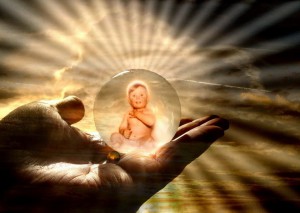24. “A Buddha has three bodies. By the Dharmakaya is meant the Dharma of the omnipresent voidness of the real self-existent Nature of everything. By the Sambhogakaya is meant the Dharma of the underlying universal purity of things. By the Nirmanakaya is meant the Dharmas of the six practices leading to Nirvana and all other such devices. The Dharma of the Dharmakaya cannot be sought through speech or hearing or the written word. There is nothing which can be said or made evident. There is just the omnipresent voidness of the real self-existent Nature of everything, and no more. Therefore, saying that there is no Dharma to be explained in words is called preaching the Dharma. The Sambhogakaya and the Nirmanakaya both respond with appearances suited to particular circumstances. Spoken Dharmas which respond to events through the senses and in all sorts of guises are none of them the real Dharma. So it is said that the Sambhogakaya or the Nirmanakaya is not a real Buddha or preacher of the Dharma.”1
1 As usual, Huang Po is using familiar Sanskrit terms in a way peculiar to himself. Usually, the Dharmakaya means the highest aspect of a Buddha, i.e. as one with the Absolute; the Sambhogakaya is the glorified Body of a Buddha in his supramundane existence; and the Nirmanakaya may be any of the various transformations in which a Buddha appears in the world. In Zen, the first is absolute truth in unimaginable and perfect form, the second is the highest concept of absolute truth of which unenlightened human beings are capable—an underlying purity and unity; the third represents the various methods by which we hope to obtain perception of absolute truth.
Huang Po has remarkable insight into the Trikaya. The Dharmakaya is likened unto an “omnipresent voidness” that is the Real Nature of Mind as Self-Present everywhere—one could say that the universe itself is in actuality an Omniverse whose essential Core-Reality is an Undifferentiated Voidness—vacuous of thing-ness yet by the same token the One Totality of all. He envisions the Sambhogakaya as breathing primordial purity into all things as a subtle body of limitless enjoyment-potential, while the Nirmanakaya is the body that manifests in expedient fashion devised to meet any present state of affairs in the created order. The Master also states, though, that while both the Sambhogakaya and Nirmanakaya make sundry appearances in order to quench the satisfaction of any given samsaric circumstance, it is the Dharma-Kaya Alone that is reflective of the Real-Buddha that speaks-unspoken (within the omnipresent voidness) the Nirvanic Word that is hidden within all Dharmas.
26. “When the Tathagata manifested himself in this world, he wished to preach a single Vehicle of Truth. But people would not have believed him and, by scoffing at him, would have become immersed in the sea of sorrow (samsara). On the other hand, if he had said nothing at all, that would have been selfishness, and he would not have been able to diffuse knowledge of the mysterious Way for the benefit of sentient beings. So he adopted the expedient of preaching that there are Three Vehicles. As, however, these Vehicles are relatively greater and lesser, unavoidably there are shallow teachings and profound teachings-none of them being the original Dharma. So it is said that there is only a One-Vehicle Way; if there were more, they could not be real. Besides there is absolutely no way of describing the Dharma of the One Mind. Therefore the Tathagata called Kasyapa to come and sit with him on the Seat of Proclaiming the Law, separately entrusting to him the Wordless Dharma of the One Mind. This branchless Dharma was to be separately practised; and those who should be tacitly Enlightened would arrive at the state of Buddhahood.”1
1 This passage demonstrates that Huang Po himself accepted the traditional origin of the Zen Sect; but, as I have pointed out in the introduction, the truth of this tradition does not affect the validity of the teaching one way or the other, since Huang Po is surely speaking from a direct experience of the One Mind.
Huang Po strongly advocates the One Vehicle of Truth (Unborn Buddha-Mind) but makes reference to the fact that the Tathagata expediently preached the Three-Vehicles that are best suited for each individual’s capacity to fathom the Buddhadharma. On the other hand, himself being a Child of the One-Mind has to point out that these vehicles in a certain sense are all limited in coming to the Noble Self-Realization that Alone reveals and constitutes the original Dharma; thus there can only Really be One-Vehicle of Truth and That is Mind-Only. Kasyapa was the one disciple who alone discerned and was entrusted with the significance, or better yet, with the Mind-Revelation that can only be a wordless-affair as signified by the silent-twirling of that flower between the blessed-fingers of the Sugata. That immaculate-moment was the birth of Zen itself, but the Master goes one step further by stating that this was meant to be a “branchless Dharma”—meaning that there can be no actual lineage within the Unborn; it’s all a tacitly-minded affair that can only be practiced in great Solitude of Mind within the Dharma-womb Itself.

